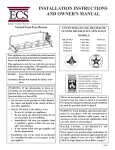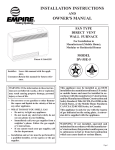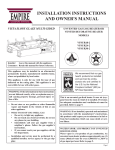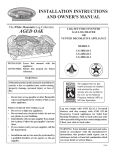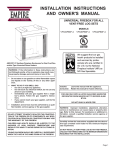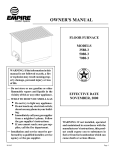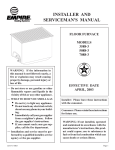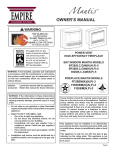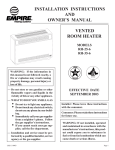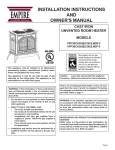Download Empire Heating Systems 7088-5 Owner`s manual
Transcript
OWNER'S MANUAL FLOOR FURNACE Models 3588-4 5088-5 7088-5 WARNING: If the information in these instructions are not followed exactly, a fire or explosion may result causing property damage, personal injury or loss of life. — Do not store or use gasoline or other flammable vapors and liquids in the vicinity of this or any other appliance. — WHAT TO DO IF YOU SMELL GAS •Do not try to light any appliance. •Do not touch any electrical switch; do not use any phone in your building. • Immediately call your gas supplier from a neighbor’s phone. Follow the gas supplier’s instructions. • If you cannot reach your gas supplier, call the fire department. Installer: Leave this manual with the appliance. Consumer: Retain this manual for future reference. WARNING: If not installed, operated and maintained in accordance with the manufacturer's instructions, this product could expose you to substances in fuel or from fuel combustion which can cause death or serious illness. — Installation and service must be performed by a qualified installer, service agency or the gas supplier. Page 1 Introduction Always consult your local Building Department regarding regulations, codes or ordinances which apply to the installation of a floor furnace. Qualified Installing Agency The installation must conform with local codes, or in the absence of local codes, with the National Fuel Gas Code ANSI Z223.1. Instructions to Installer 1. Installer must leave instruction manual with owner after installation. 2. Installer must have owner fill out and mail warranty card supplied with furnace. 3. Installer should show owner how to start and operate furnace and thermostat. State of Massachusetts: The installation must be made by a licensed plumber or gas fitter in the Commonwealth of Massachusetts. Warning: Any change to this furnace or its control can be dangerous. This is a heating appliance and any panel, door or guard removed for servicing an appliance must be replaced prior to operating the appliance. Important All correspondence should refer to complete Model Number, Serial Number and type of gas. Notice: During initial firing of this furnace, its paint will bake out and smoke will occur. To prevent triggering of smoke alarms, ventilate the room in which the furnace is installed. To Conserve Gas: Turn off pilot when heater is not in use. General Information This series is design certified in accordance with American National Standard Z21.86b-2002 by the Canadian Standards Association as a gravity type Floor Furnace and must be installed according to these instructions. Any alteration of the original design, installed other than as shown in these instructions or use with a type of gas not shown on the rating plate is the responsibility of the person and company making the change. The flue pipe diameter must be as large as the flue collar on the draft diverter and run as directly as possible to the chimney at least 1/4" rise per foot of run properly supported by metal straps, and enter the chimney so the end of the flue pipe is flush with the inner wall of the chimney. Any flue pipe passing through walls and roof must be "B" type vent. The chimney must extend at least two feet above the roof and any object or building within 10 feet of the chimney. The flue pipe must NOT have any open tees or be connected to the chimney of an existing fireplace. Specifications Models Input BTU/HR 3588 5088 7088 32,500 45,000 65,000 33 3/4" x 22 3/4" 36 3/4" x 24 3/4" 36 3/4" x 32 3/4" 32" x 20" 34" x 22" 34" x 30" 40" 43 1/2" 45 1/4" 32 5/16" x 20 5/16" 34 5/16" x 22 5/16" 34 5/16" x 30 5/16" 23" 26" 27" Dimensions Register Length & Width Casing Length & Width Overall Length Including Diverter Floor Opening, Length & Width Height Minimum Clearance to Combustibles Top Must Be Open and Clear of ALL OBJECTS and Covering Each Side to: Nearest Wall 6" 6" 6" Bottom of Unit for Air 6" 6" 6" Draft Diverter and Vent Connector 6" 6" 6" Two Adjoining Sides to Walls to Provide a Walkway 18" 18" 18" 1/2" 1/2" 1/2" 18 1/2" 20 1/4" 20 1/4" Gas Inlet Iron pipe Size (N.P.T.) Inlet to Floor Venting Floor to Top of Diverter Shield 10 1/2" 12 3/4" 12 3/4" Center of Flue (Horizontal) to Floor Covering 17 1/4" 18 3/4" 17 3/4" Size of Flue Collar 4" Dia. 4" Dia. 5" Dia. 32196-0-0513 Page 2 This Is a Heating Appliance DO NOT OPERATE THIS APPLIANCE WITHOUT FLOOR REGISTER INSTALLED •Due to high temperatures the appliance should be located out of traffic and away from furniture and draperies. • •Do not use this heater if any part has been under water. Immediately call a qualified service technician to inspect the heater and to replace any part of the control system and any gas control which has been under water. Children and adults should be alerted to the hazards of high surface temperatures and should stay away to avoid burns or clothing ignition. • • Young children should be carefully supervised when they are in the same room as the appliance. Floor furnace must not be connected to a chimney flue serving a separate solid fuel burning appliance. • • Clothing or other flammable material should not be placed on or near the appliance. The draft hood shall be installed so as to be in the same atmospheric pressure zone as the combustion air inlet to the appliance. • Any safety screen or guard removed for servicing an appliance must be replaced prior to operating the appliance. • A burn hazard can occur in the use of the floor furnace when the temperature control (limit) is in the manual override position. • Installation and repair should be done by a qualified service person. The appliance should be inspected before use and at least annually by a qualified service person. More frequent cleaning may be required due to excessive lint from carpeting, bedding materials, etc. It is imperative that control compartments, burners and circulating air passageways of the appliance be kept clean. • Contact of bare skin with the hot air register may result in burns when the floor furnace is in operation. Page 3 32196-0-0513 SAFETY INFORMATION FOR USERS OF LP-GAS Propane (LP-Gas) is a flammable gas which can cause fires and explosions. In its natural state, propane is odorless and colorless. You may not know all the following safety precautions which can protect both you and your family from an accident. Read them carefully now, then review them point by point with the members of your household. Someday when there may not be a minute to lose, everyone’s safety will depend on knowing exactly what to do. If, after reading the following information, you feel you still need more information, please contact your gas supplier. LP-GAS WARNING ODOR some points to remember • Learn to recognize the odor of LP-gas. Your local LP-Gas Dealer can give you a “Scratch and Sniff” pamphlet. Use it to find out what the propane odor smells like. If you suspect that your LP-Gas has a weak or abnormal odor, call your LP-Gas Dealer. • If you are not qualified, do not light pilot lights, perform service, or make adjustments to appliances on the LP-Gas system. If you are qualified, consciously think about the odor of LP-Gas prior to and while lighting pilot lights or performing service or making adjustments. • Sometimes a basement or a closed-up house has a musty smell that can cover up the LP-Gas odor. Do not try to light pilot lights, perform service, or make adjustments in an area where the conditions are such that you may not detect the odor if there has been a leak of LP-Gas. • Odor fade, due to oxidation by rust or adsorption on walls of new cylinders and tanks, is possible. Therefore, people should be particularly alert and careful when new tanks or cylinders are placed in service. Odor fade can occur in new tanks, or reinstalled old tanks, if they are filled and allowed to set too long before refilling. Cylinders and tanks which have been out of service for a time may develop internal rust which will cause odor fade. If such conditions are suspected to exist, a periodic sniff test of the gas is advisable. If you have any question about the gas odor, call your lp-gas dealer. A periodic sniff test of the lp-gas is a good safety measure under any condition. If a gas leak happens, you should be able to smell the gas because of the odorant put in the LP-Gas. That's your signal to go into immediate action! • Do not operate electric switches, light matches, use your phone. Do not do anything that could ignite the gas. • Get everyone out of the building, vehicle, trailer, or area. Do that IMMEDIATELY. • Close all gas tank or cylinder supply valves. • LP-Gas is heavier than air and may settle in low areas such as basements. When you have reason to suspect a gas leak, keep out of basements and other low areas. Stay out until firefighters declare them to be safe. • Use your neighbor’s phone and call a trained LP-Gas service person and the fire department. Even though you may not continue to smell gas, do not turn on the gas again. Do not re-enter the building, vehicle, trailer, or area. • Finally, let the service man and firefighters check for escaped gas. Have them air out the area before you return. Properly trained LP-Gas service people should repair the leak, then check and relight the gas appliance for you. If, at any time, you do not smell the LP-Gas odorant and you think you should, assume you have a leak. Then take the same immediate action recommended above for the occasion when you do detect the odorized LP-Gas. • If you experience a complete “gas out,” (the container is under no vapor pressure), turn the tank valve off immediately. If the container valve is left on, the container may draw in some air through openings such as pilot light orifices. If this occurs, some new internal rusting could occur. If the valve is left open, then treat the container as a new tank. Always be sure your container is under vapor pressure by turning it off at the container before it goes completely empty or having it refilled before it is completely empty. • no odor detected - odor fade Some people cannot smell well. Some people cannot smell the odor of the chemical put into the gas. You must find out if you can smell the odorant in propane. Smoking can decrease your ability to smell. Being around an odor for a time can affect your sensitivity or ability to detect that odor. Sometimes other odors in the area mask the gas odor. People may not smell the gas odor or their minds are on something else. Thinking about smelling a gas odor can make it easier to smell. The odorant in LP-gas is colorless, and it can fade under some circumstances. For example, if there is an underground leak, the movement of the gas through soil can filter the odorant. Odorants in LP-Gas also are subject to oxidation. This fading can occur if there is rust inside the storage tank or in iron gas pipes. The odorant in escaped gas can adsorb or absorb onto or into walls, masonry and other materials and fabrics in a room. That will take some of the odorant out of the gas, reducing its odor intensity. LP-Gas may stratify in a closed area, and the odor intensity could vary at different levels. Since it is heavier than air, there may be more odor at lower levels. Always be sensitive to the slightest gas odor. If you detect any odor, treat it as a serious leak. Immediately go into action as instructed earlier. 32196-0-0513 Page 4 General Instructions Follow a few simple rules and your Empire furnace will give you years of trouble-free heating. When your furnace is ready for installation, operation or repair here are a few DO's and DON'T's. WALL THERMOSTAT MANUALS (2) Don't install the furnace yourself if you are not qualified in working with gas piping, chimneys, flue pipes, and venting. Gas appliances and gas piping should be installed or repaired only by a qualified serviceman. DO get a qualified installing agency to install your furnace. By the term "qualified installing agency" is meant any individual, firm, corporation or company which either in person or through a representative is engaged in and is responsible for the installation or replacement of gas piping on the outlet side of the meter, or of the service regulator when a meter is not provided; or the connection, installation or repair of gas appliances, who is experienced in such work, familiar with all precautions required; and has complied with all the requirements of the authority having jurisdiction. REGISTER FLOOR CUTOUT TEMPLATE PILOT LIGHTING HOLD COVER Do refer to your Empire Installer and Serviceman's Manual so that you can make sure that all installation and service work was done properly. You bought the best furnace, now make sure you get the best service. Do make sure your venting system and flue pipe were installed as outlined in your Empire Installer and Serviceman's Manual. Do see "Using Your Furnace" before you try to light the pilot or turn your furnace on. Do see "Using Your Furnace" for instructions on how to set the register temperature control when children are present. To Conserve Gas: Turn off pilot when heater is not in use. Caution Floor register becomes hot when operating and can cause burns. Keep children off! Don't adjust or repair the combination valve, and don't take it apart. Don't try to make any repairs except the ones listed for you to do in Service Checks. Did You Get Everything? After you have unpacked your Empire furnace, you should make certain everything is in order. For example, did you receive the model furnace you ordered? Is it the model for the type of gas (Natural or Propane) you want? Did you get all of the parts you are supposed to have? Look at picture A. It will tell you where your furnace identification plate is. The plate has stamped on it the model and serial number of the furnace you received. It also tells if your furnace is supposed to use natural (NAT) or propane (LP) gas. See if the serial number on your furnace is the same as the number on the WARRANTY CARD. Be sure your dealer fills out the WARRANTY CARD, then MAIL the purchaser's report (bottom part) to us. Look at Picture A and also the list below to see if you have received everything on the list. If anything is missing or broken, or if the model or serial numbers are not right, or if the furnace is for natural and you have propane (or the other way around), contact your dealer or Empire Comfort Systems, Inc. Page 5 DRAFT DIVERTER WARRANTY CARD PACKED IN SEPARATE CARTON The installation must conform with local codes, or in the absence of local codes, with the National Fuel Gas Code ANSI Z223.1. *Available from the American National Standards Institute, Inc., 11 West 42nd St., New York, N.Y. 10036. Do consult your dealer and local gas supplier about qualified installers and servicemen. INNER CASING IDENTIFICATION PLATE (INSIDE) LIGHTING ROD (MATCH HOLDER) DEBRIS PAN Figure A 1. 2. 3. 4. 5. 6. 7. 8. 9. 10. Owner's manual (you are reading it now) Installer and Serviceman's Manual Wall thermostat (packed in draft diverter carton) Draft diverter (packed in separate carton) Cardboard cutout template (inside top of furnace box) Register (top of furnace) Warranty card Debris pan Lighting rod (inside furnace lying on bottom) Inner casing (inside furnace) HOW YOUR FURNACE WORKS HEATING Your Empire furnace uses air from two places; air from outside the living area, and air from inside the living area. The air from outside the living area is mixed with gas and burned inside a chamber in your furnace. The burned gas and air is exhausted through a flue pipe to the outside air again. This exhaust should not be permitted to enter the living area. Burning gas inside the furnace chamber makes the chamber hot. Cool air from inside the living area is drawn into the furnace and flows past the outside of the hot chamber. The chamber makes this air hot and this hot air flows out of the furnace and back into the living area. When enough air in the living area has been heated, the thermostat turns the furnace off automatically. Picture B shows the flow of air inside and air outside the living area. You can see that the air inside is not mixed with air outside the living area. The furnace does not burn air that is within your living area, and burned air or exhaust should not enter the living area. 32196-0-0513 Insulated Vent Enclosure Vented floor furnace installed with the vent going directly to the outside and above the eaves can cause poor venting. The cold vent pipe will have a delay in proper venting and cause spillage of flue products at the draft diverter. The spillage of flue products can result in pilot outage due to recirculation of flue products into the main burner, also, condensation can occur in the vent pipe which can cause an ice build-up or rusting of the draft diverter. To prevent delayed venting as well as condensation of flue products an insulated vent enclosure is recommended. Use Type B vent pipe and maintain at least a one inch clearance to combustibles. Use metal thimble to protect vent pipe as it passes through combustibles. Venting Good venting is essential to good dependable heat. Venting removes the exhaust that results when gas is burned inside your furnace. If the exhaust is not vented away, the exhaust may gather under your house and could seep into the house and be fatal. Venting is done through a vent pipe (chimney) which, when correctly installed, causes a draft (suction) at the end of the pipe that is connected to the draft diverter. This suction carries away the exhaust from your furnace. The vent pipe is connected to the draft diverter which is mounted onto the furnace during installation. See Figure B. Refer to the Installer and Serviceman's Manual for instructions on how to properly vent your furnace. Remember, exhaust fumes, whether they come from your furnace or your car, can be fatal. Wall Thermostat The wall thermostat is simply a switch that turns on when it is cold and off when it is comfortable. When the thermostat turns on it connects the small amount of electricity to the main gas valve (part of combination valve in furnace), which then opens. Now the pilot lights the gas and your furnace is on. When the living area is warm enough, the wall thermostat switches off, the main gas valve closes and your furnace turns off. The pilot remains lit waiting to light the gas the next time the thermostat calls for heat and turns the furnace on. Temperature controls Your Empire furnace has two safety switches (limits). When either switch turns off, it turns your furnace off, even if the wall thermostat is calling for heat. One of these switches can be moved to a Low Heat or a full heat position. In Full heat position the register becomes very hot when the furnace heats the living area. In low heat position the switch will turn the furnace off and on again a few times before the living area is comfortable but it stops the register from getting as hot as the FULL HEAT position. Draft Diverter The draft diverter is a collection box that is attached to the exhaust end of your furnace. The draft diverter is a very important unit and has two major functions: 1. It dilutes the flue products with cooler air. 2. It allows the furnace to burn properly during temporary downdrafts. Check the draft diverter and entire vent system each year for rust damage and proper assembly. Combination valve The combination valve in the furnace controls the gas. This valve has a control handle with three positions marked: off, pilot and On. When the handle is at OFF, all gas is cut off. When the handle is at pilot, the pilot can be lit. When the handle is at on, the gas will flow to the burner providing the pilot is lit and the wall thermostat calls for heat. HOT AIR Using your furnace HOT AIR before you turn it on Look down inside your furnace and make sure there isn't any paper, packing material, or trash that could catch fire. Turn your thermostat off or to its lowest temperature setting. See if the furnace control handle is turned to OFF. See Figure C. HOT AIR VENT PIPE (CHIMNEY TYPE B) COOL AIR COOL AIR VENT PIPE OUTSIDE AIR GAS SUPPLY EXHAUST OUTSIDE DRAFT AIR DIVERTER BURNER CHAMBER OUTSIDE AIR SUPPLY Figure B Furnace features Caution If the furnace control handle was not at OFF, turn it to OFF and wait ten minutes before lighting a match or the pilot. Note You must press down on the furnace control handle to make it turn to OFF. You are now ready to light the pilot. No electricity needed (Self Generating Pilot Control) Your Empire furnace does not need electricity from your house; it makes its own. When the pilot is lit, its heat is used to generate a tiny amount of electricity (about 1/2 volt) which is all that is needed by your furnace. This small amount of electricity keeps the pilot valve (part of combination valve in furnace) open so the pilot stays on. The small amount of electricity is also used with the wall thermostat to turn on the furnace automatically when heat is needed, and turn it off when it is comfortable. 32196-0-0513 Page 6 Where there's fire, there's smoke —sometimes If your furnace has never been used before, it will smoke a little the first time it gets hot. This is normal and will only last for a short time. Open a window to clear away the smoke. In about ten minutes the smoke will stop and you can look forward to many years of SMOKELESS heat. LIGHTING ROD (MATCH HOLDER) THERMOSTAT PUSH HERE MATCH GOES HERE COVER WINDOW FURNACE CONTROL HANDLE PILOT LIGHTING HOLE Figure C Don't put anything around the furnace that will obstruct the flow of combustion and ventilation air. Do keep the appliance area clear and free from combustible material, gasoline and other flammable vapors and liquids. Do contact a Qualified Installer when planning the installation. Children crawling around Your Empire furnace is very efficient and gives off a great deal of heat. So, when your floor furnace is turned on, the floor REGISTER IS HOT! CAUTION The warm air floor register of a floor furnace, due to the high discharge air temperatures and radiation from heating surfaces, attains temperature sufficiently high to cause severe burns. KEEP CHILDREN OFF! You can reduce the heat of the register by moving the register temperature control. Register temperature control The register temperature control has two positions. LOW HEAT (Black) output, see D, and FULL HEAT (Red) output, see E. Use the low position when children are present. This will cause your furnace to turn off and on several times before the living area is completely comfortable. This is normal and limits the register temperature to a maximum of 235°F. Do read our Installer and Serviceman's Manual so that you will know enough to be able to make sure your furnace has been installed and vented properly. Do examine venting systems periodically and replace damaged parts. Do examine burners periodically. Clean and replace damaged parts. Make periodic visual check of pilot and burner flame. Piezo lighting instructions This furnace is equipped with a Piezo (spark) ignitor for lighting the pilot without removing the lighter hole cover. A lighter rod is supplied and can be used to see if the pilot is getting gas and also for faster lighting when there is excessive air in the lines. D E Turning your furnace on Don't try to light the pilot by dropping lit matches into your furnace. A match could fall through and start a fire under your house. If your pilot is lit, and the lighting hole window and cover are tightly closed, you are ready to turn on your furnace. You turn your furnace on in two easy steps: Step 1. Turn the furnace control handle to ON. Step 2. Set your wall thermostat for the temperature you like. It's as simple as that. Caution NEVER run your furnace with the lighting hole open or with a broken lighting hole window. Exhaust gases can get into the living area through an open lighting hole and be fatal. Page 7 F Note When using the LOW HEAT position make sure that the control is resting against the furnace chamber. Sometimes the wire may hold it away. Pull slack into wire and make sure the control is all the way down. 32196-0-0513 FOR YOUR SAFETY READ BEFORE LIGHTING Warning: If you do not follow these instructions exactly, a fire or explosion may result causing property damage, personal injury or loss of life. A. This appliance has a pilot which must be lighted by hand. When lighting the pilot, follow these instructions exactly. B. Before lighting smell all around the appliance area for gas. Be sure to smell next to the floor because some gas is heavier than air and will settle on the floor. What To Do If You Smell Gas •Do not try to light any appliance. •Do not touch any electrical switch; do not use any phone in your building. • Immediately call your gas supplier from a neighbor's phone. Follow the gas supplier's instructions. • If you cannot reach your gas supplier, call the fire department. C. Use only your hand to push in or turn the gas control handle. Never use tools. If the handle will not push in or turn by hand, don't try to repair it; call a qualified service technician. Force or attempted repair may result in a fire or explosion. D. Do not use this appliance if any part has been under water. Immediately call a qualified service technician to inspect the appliance and to replace any part of the control system and any gas control which has been under water. Lighting Instructions 1. Stop! Read the safety information above. 2. Set the thermostat to lowest setting (if applicable). 3. Remove floor register. NOTE: The gas control handle is attached to the gas control knob. 4. Push in gas control handle slightly and turn clockwise to "OFF." Note: Handle cannot be turned from "PILOT" to "OFF" unless handle is pushed in slightly. Do not force. portion of the main burner in the area directly below the pilot access opening. 8. Turn gas control handle counterclockwise to "PILOT." 3588 5088 7088 9. Push and hold control handle in and repeatedly push the ignitor button until pilot is lit (or use match and lighter rod to light.) Continue to hold the control handle in for about one (1) minute after the pilot is lit. Release handle and it will pop back up. Pilot should remain lit. If it goes out, repeat steps 4 through 9. • If handle does not pop up when released, stop and immediately call a qualified service technician or gas supplier. • If the pilot will not stay lit after several tries, turn the gas control handle to "OFF" and call your service technician or gas supplier. 10. Replace pilot access cover. 5. Remove the pilot access cover located on the combustion chamber. 11. Turn gas control handle counterclockwise "ON." 6. Wait ten (10) minutes to clear out any gas. Then smell for gas, including near the floor. If you smell gas, STOP! Follow "B" in the safety information above. If you don't smell gas, go to the next step. 12. Replace floor register. to 13. Set thermostat to desired setting (if applicable). 7. Find pilot- the pilot is adjacent to the center To Turn Off Gas To Appliance 1. Set the thermostat to lowest setting (if applicable). 3. Push in gas control handle slightly and turn clockwise to "OFF." Do not force. 2. Remove floor register. 4. Replace floor register. 32196-0-0513 Page 8 Some helpful warnings • • • • • Use low heat output when children are nearby. Do not cover the floor register when the furnace or pilot is turned on. Do not restrict the flow of air around the register by placing a screen under it. Do not dry clothes or any objects by putting them on floor register because this creates a fire hazard. Do not hang clothes or any object above or over floor register Floor register is HOT when furnace is operating. Floor register can cause burns . Keep children OFF of the floor register. (Provide fence or register guard for their protection.) Use the FULL HEAT output during cold weather and only when no children are around. In this position, your furnace will keep running until the living area is completely heated or unless something is covering the floor register. If the register is half covered, your furnace will turn off. Millivolt Information 500 average with the thermostat OFF. 225 average with the thermostat ON. 140 minimum for valve to open. 65 minimum for pilot to stay on. Service Checks Here is a list of the things you can do if your furnace stops running properly or won't turn on. DO NOT make repairs to anything not on this list; instead, call your serviceman. Only a qualified serviceman should make repairs or replace parts on gas appliances. • because this too creates a fire hazard. During warm weather months, turn to full OFF position before you cover the register with a rug, because this too creates a fire hazard. CAUTION: Label all wires prior to disconnection when servicing controls. Wiring errors can cause improper and dangerous operation. Verify operation after servicing. To Conserve Gas: Turn off pilot when heater is not in use. Have Trouble? Do This 1. Pilot won't light. a. Call your gas supplier to check if the gas supply is normal. b. Call your serviceman. 2. Pilot lights but goes out when furnace control handle is released and pops up. a. Relight and wait 60 seconds before releasing control handle. b. Check generator wires (see G) and screws on combination valve terminals for tightness. c. Call your serviceman. It is important to use wire of a gauge proper for the length of the wire: RECOMMENDED WIRE GAUGES Maximum Length Wire Gauge 1' to 10' 18 10' to 25' 16 25' to 35' 14 Warning A 6" clearance must be maintained between the flue or vent connector and beneath the entire bottom of the appliance. This appliance needs fresh air for safe operation and must be installed so there are provisions for adequate combustion and ventilation air. Flue pipe that stops on the side of the building will not vent during certain wind and/or temperature conditions and will cause flue products to accumulate under the house and can be fatal to occupants. Unit Must Be Wired As Shown If any of the original wire as supplied with appliance has to be replaced, it should be replaced by No. 18 Gauge 150° C wire or its equivalent. This unit has a limit control connected in series with the gas valve to shut the gas off in case of inadvertent covering of the register during a heating cycle and can be positioned to reduce register temperature. G Page 9 32196-0-0513 3. 4. Pilot lights but furnace won't turn on. a. Turn furnace control rod to ON. b. Check thermostat to make sure it's turned up high enough. c. Check thermostat connections to make sure wires are connected tightly. d. Turn furnace control handle to OFF and check main burner for dirt (see G, J). Clean as shown in CARE AND CLEANING. e. Turn furnace control handle to ON. f. If furnace still won't turn on, call serviceman. Furnace won't keep running. a. Is the register covered? Uncover register. b. Thermostat too close to furnace. Relocate it. c. Inner casing missing (see H). Replace it. d. Check draft diverter, vent pipe, type B or masonry chimney for damage, blockage or leakage. If the furnace does not have proper venting, the exhaust fumes can extinguish the burner flame. e. Call your serviceman. 5. Thermostat won't turn the furnace off. a. Check the wires in the thermostat for a possible short circuit (touching each other). b. Check the thermostat wires at the combination valve (see G) for a possible short circuit. c. Trace the thermostat wires to see if any staples used to hold the wire against the wall or ceiling are too tight, causing them to touch. d. Call your serviceman. Turning Off Your Pilot You turn your pilot off (complete shutdown of furnace in two easy steps: Step 1. Turn the furnace control handle (see C) to PILOT. Step 2. Press the furnace control handle down and then turn to OFF. Release the handle. To restart your furnace see "Lighting the Pilot." Care AND Cleaning You can have years of clean, efficient, trouble-free heating from your Empire floor furnace for the price of just a few minutes of your time each month. The main cause of furnace problems is dirt. Dirt Will Hurt During normal use, air flow in your house will carry tiny, unseen particles of dust into the furnace. They will gather there by the millions and after a time you will began to see them clinging to the inside of your furnace. This dust holds some of the heat within the furnace instead of releasing it to heat the living area. Caution For proper operation, furnace must be kept clean. At regular intervals turn manual valve to OFF, let cool, remove register and clean dust and foreign material from jacket with vacuum cleaner. Keep It Clean Use a vacuum cleaner or dust brush to clean your furnace. It will take only a few minutes and you should do it once a month during normal use. Here's what you should do: Step 1. Turn your wall thermostat all the way down. Step 2. Allow 30 minutes for the furnace to cool down. Step 3. Remove the floor register. Step 4. Turn the furnace control handle to OFF (see H). • • Do not turn the furnace on without the inner casing in place (see F). Do not operate your furnace with a broken lighting hole window or without the cover closed. Turning Your Furnace Off You turn your furnace off by simply turning the furnace control handle (see C) to Pilot. This stops your furnace from turning on but keeps the pilot lit so that if you want to turn it on again you only have to turn the furnace control handle to ON. 32196-0-0513 Figure H Page 10 Step 5. Put the register temperature control into the FULL HEAT position (see H). Step 6. Spread old newspapers on the floor. Step 7. Lift out the inner casing and put it on the newspaper. Step 8. Vacuum or brush away all dust and dirt clinging to the inside and outside of the inner casing. Step 9. Brush all dust off the chambers and inside walls of the furnace and use a vacuum cleaner hose to pick up dust that falls to the bottom of furnace (see I). Bugs mean trouble If your furnace has been turned off for a few weeks or during the summer, you may have some trouble getting it started again. Part of the main burner at the bottom of you're furnace (see J) is a favorite hiding place for the common spider. It likes to spin a web and lay eggs there and sometimes this blocks the flow of gas through the orifice and main burner. Use a soft brush (clean paint brush) and clean around the orifice. This may clear up any trouble. If not, refer to Service Checks, or call a qualified serviceman. DON'T unscrew the orifice or try to clear it by pushing anything through the tiny hole. Call your qualified serviceman. ORIFICE USE SOFT BRUSH IN HERE TO CLEAN AROUND ORIFICE MAIN BURNER Figure I Step 10. If you do not have a vacuum cleaner, brush off the furnace with a dust brush or small hand broom and then use a damp rag to pick up the dust at the bottom of the furnace. Step 11. Look into the furnace and make sure all rags and brushes are removed and that no trash is lying in the bottom of the furnace. Figure J Step 12. Grasp the inner casing at the top edge (do not lift by slots, you could pinch your fingers) and lower the casing onto its support brackets inside the furnace. Step 13. Light the pilot and turn the furnace control handle to ON. Step 14. Turn the wall thermostat up enough to turn the furnace on. Step 15. Check to see if the furnace turned on; that is, do you feel heat? If furnace does not turn on, refer to Service Checks. Caution Don't use any kind of solvent or cleaning fluid to clean your furnace. It can leave a residue or invisible coating on your furnace that might burn or smell when you turn your furnace on. Use only a damp cloth. Step 16. Set the register temperature control to the desired position. Set it to LOW HEAT output if children are present. Step 17. Replace the floor register. Page 11 32196-0-0513 MASTER PARTS DISTRIBUTOR LIST To Order Parts Under Warranty, please contact your local Empire dealer. See the dealer locator at www.empirecomfort. com. To provide warranty service, your dealer will need your name and address, purchase date and serial number, and the nature of the problem with the unit. To Order Parts After the Warranty Period, please contact your dealer or one of the Master Parts Distributors listed below. This list changes from time to time. For the current list, please click on the Master Parts button at www.empirecomfort.com. Please note: Master Parts Distributors are independent businesses that stock the most commonly ordered Original Equipment repair parts for Heaters, Grills, and Fireplaces manufactured by Empire Comfort Systems Inc. Dey Distributing 1401 Willow Lake Boulevard Vadnais Heights, MN 55101 Phone: 651-490-9191 Toll Free: 800-397-1339 Website: www.deydistributing.com Parts: Heater, Hearth and Grills East Coast Energy Products 10 East Route 36 West Long Branch, NJ 07764 Victor Division of F. W. Webb Company 200 Locust Street Hartford, CT 06114 Phone: 732-870-8809 Toll Free: 800-755-8809 Fax: 732-870-8811 Website: www.eastcoastenergy.com Parts: Heater, Hearth and Grills Phone: 860-722-2433 Toll Free: 800-243-9360 Fax: 860-293-0479 Toll Free Fax: 800-274-2004 Websites: www.fwwebb.com & www.victormfg.com Parts: Heater, Hearth and Grills HOW TO ORDER REPAIR PARTS Parts Not Under Warranty Parts can be ordered through your Service Person, Dealer, or a Master Parts Distributor. See this page for the Master Parts Distributors list. For best results, the service person or dealer should order parts through the distributor. Parts can be shipped directly to the service person/dealer. Warranty Parts Warranty parts will need a proof of purchase and can be ordered by your Service Person or Dealer. Proof of purchase is required for warranty parts. All parts listed in the Parts List have a Part Number. When ordering parts, first obtain the Model Number and Serial Number from the name plate on your equipment. Then determine the Part Number (not the Index Number) and the Description of each part from the following illustration and part list. Be sure to give all this information . . . Appliance Model Number Appliance Serial Number Part Description Part Number Type of Gas (Propane or Natural) Do not order bolts, screws, washers or nuts. They are standard hardware items and can be purchased at any local hardware store. Shipments contingent upon strikes, fires and all causes beyond our control. 32196-0-0513 Page 12 APPLIANCE SERVICE HISTORY Date Dealer Name Page 13 Service Technician Name Service Performed/Notes 32196-0-0513 APPLIANCE SERVICE HISTORY Date Dealer Name 32196-0-0513 Service Technician Name Service Performed/Notes Page 14 WARRANTY Empire Comfort Systems Inc. warranties this space heating product to be free from defects at the time of purchase and for the periods specified below. Space heating products must be installed by a qualified technician and must be maintained and operated safely, in accordance with the instructions in the owner’s manual. This warranty applies to the original purchaser only and is not transferable. All warranty repairs must be accomplished by a qualified gas appliance technician. Limited Ten-Year Parts Warranty – Combustion Chamber Empire promises to the owner that if the combustion chamber (see parts list) fails because of defective workmanship or material with ten years from the date of purchase, Empire will repair or replace at Empire’s option. Limited One-Year Parts Warranty – Remote Controls, Thermostats, Accessories, and Parts Should any remote control, thermostat, accessory, or other part fail because of defective workmanship within one year from the date of purchase, Empire will repair or replace at Empire’s option. Duties Of The Owner The appliance must be installed by a qualified installer and operated in accordance with the instructions furnished with the appliance. A bill of sale, cancelled check, or payment record should be kept to verify purchase date and establish warranty period. Ready access to the appliance for service. What Is Not Covered Damages that might result from the use, misuse, or improper installation of this appliance. Travel, diagnostic costs and freight charges on warranted parts to and from the factory. Claims that do not involve defective workmanship or materials. Unauthorized service or parts replacements. Removal and reinstallation cost. Inoperable due to improper or lack of maintenance. How To Get Service To make a claim under this warranty, please have your receipt available and contact your installing dealer. Provide the dealer with the model number, serial number, type of gas, and purchase verification. The installing dealer is responsible for providing service and will contact the factory to initiate any warranted parts replacements. Empire will make replacement parts available at the factory. Shipping expenses are not covered. If, after contacting your Empire dealer, service received has not been satisfactory, contact: Consumer Relations Department, Empire Comfort Systems Inc., PO Box 529, Belleville, Illinois 62222, or send an e-mail to [email protected] with “Consumer Relations” in the subject line. Your Rights Under State Law This warranty gives your specific legal rights, and you may also have other rights, which vary from state to state. Page 15 32196-0-0513 EMPIRE Comfort Systems Empire Comfort Systems Inc. 918 Freeburg Ave. Belleville, IL 62220 If you have a general question about our products, please e-mail us at [email protected]. If you have a service or repair question, please contact your dealer. www.empirecomfort.com 32196-0-0513 Page 16
















